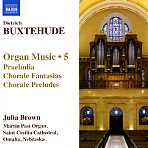Now that the hoopla of the 2006 “Mozart Year” is past, we are free to turn our ears–and commemorative spirit–toward another eminent and influential master, namely Dietrich Buxtehude, who died exactly 300 years ago in 1707. His impact on J.S. Bach is well known, and it’s interesting as we listen today to note how introspective and stylistically unfettered he could be, especially in the more improvisatory-sounding preludes.
The organ used here, from Omaha, Nebraska’s St. Cecilia Cathedral, has specifications remarkably similar to those of Buxtehude’s instrument at the Marienkirche in Lübeck known as the “Totentanz Orgel”, and organist Julia Brown takes full advantage of the brighter flues, rich mixtures, and colorful reeds to give each work a notable presence and well-defined character. I especially enjoyed her unusual choice of flute stops in the Fugue in G major Bux WV 175 and the exhilarating buildup to the conclusion of the great Toccata in F major that ends the program.
Brown is unquestionably a first-class artist and superb technician, but she also proves a serious Buxtehudian and an exceptionally sensitive stylist regarding the critical aspects of balancing voices and ensemble-building. The Martin Pasi Organ is a magnificent instrument, and the engineering does full justice to its solo and ensemble configurations. This is another fine addition to Naxos’ Buxtehude series and a must for organ fans! [1/29/2007]
































